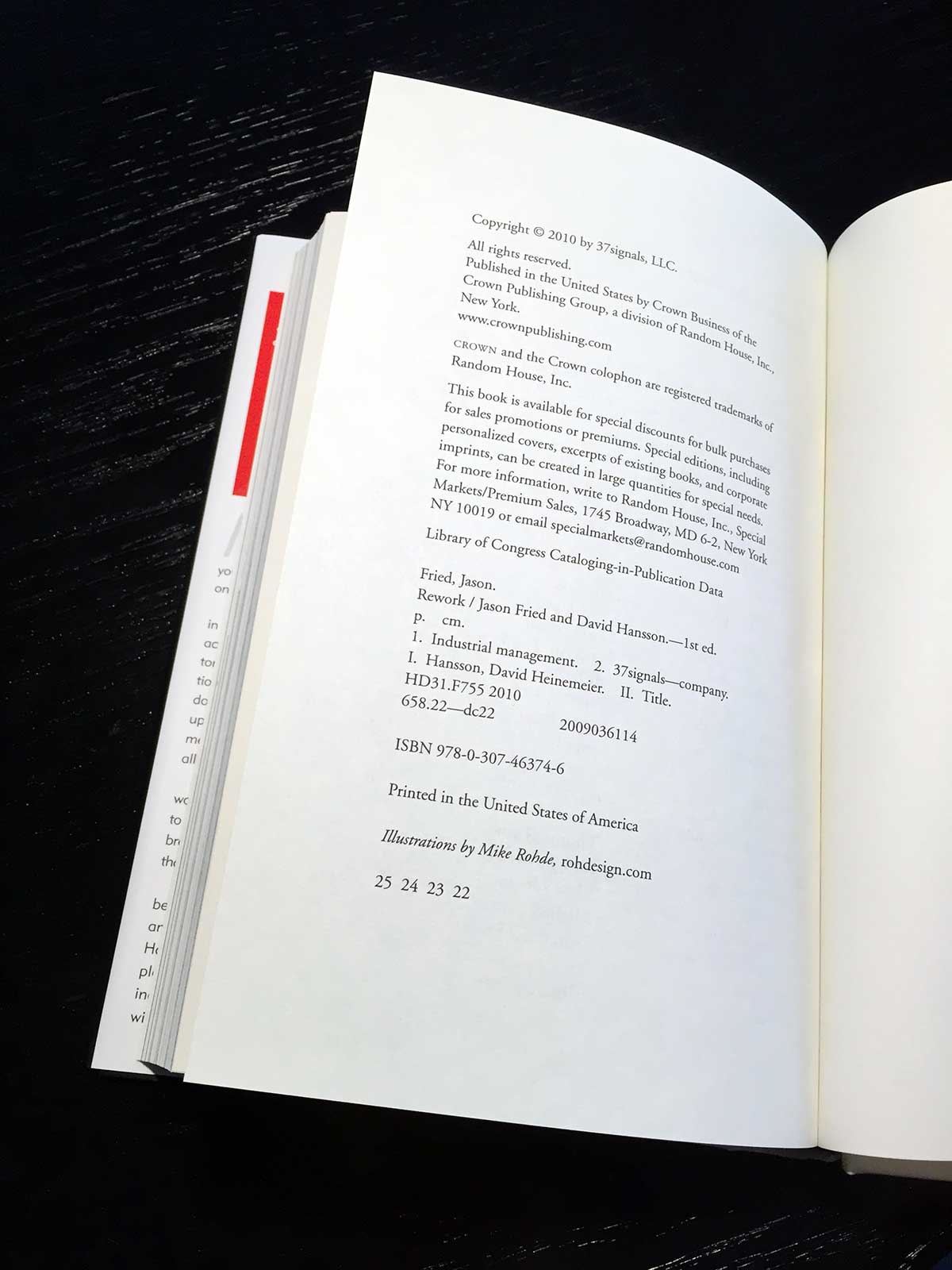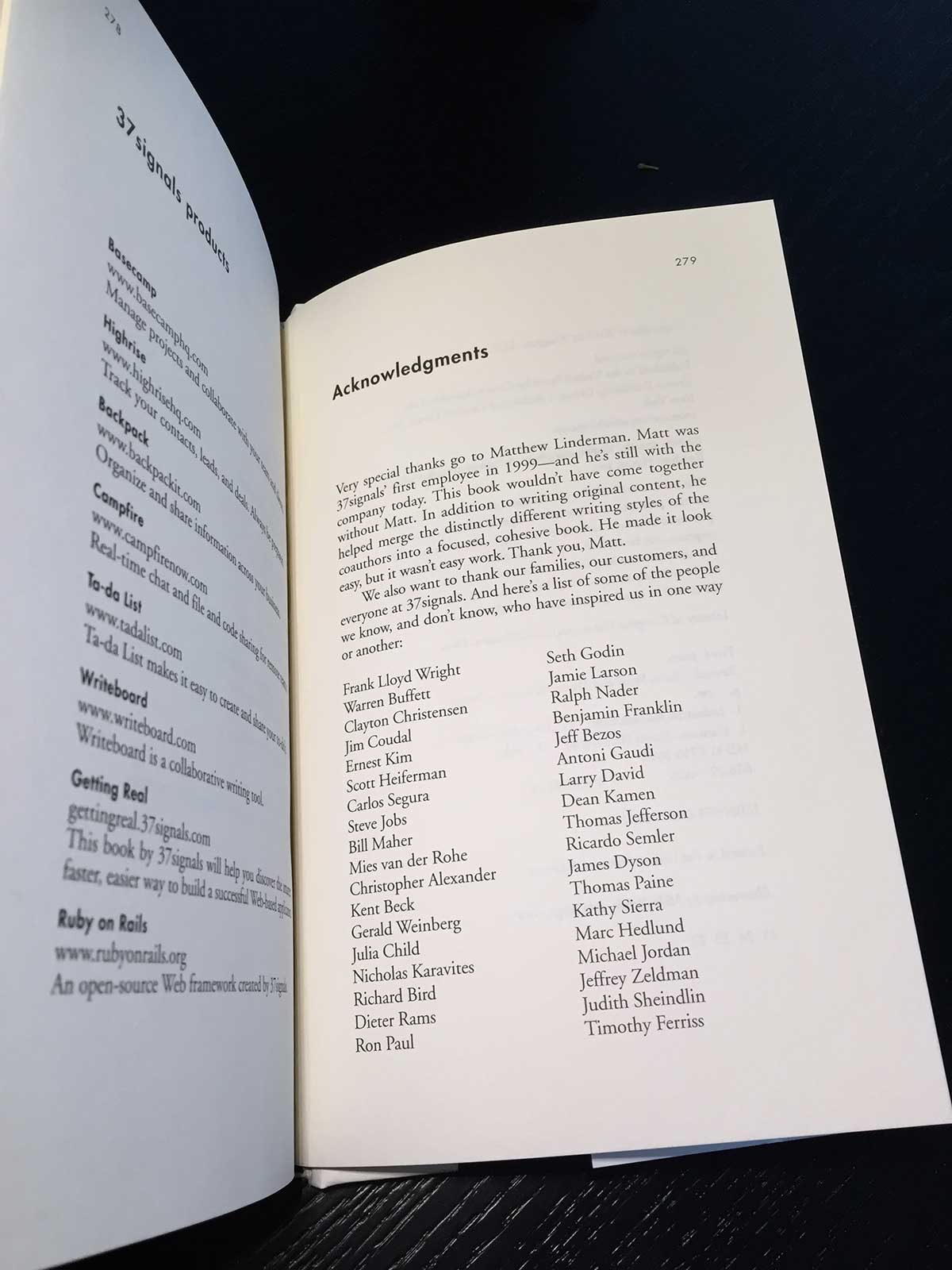Whenever I dive into something new, I try to find at least one “why the hell not?” moment. And when I can, I try to leave evidence of that moment in whatever it is that I’m building.
When we launched our company (37signals) back in 1999, we launched a black and white, text-only site without a single piece of portfolio work to be found. All the other agencies we were competing with had very flashy pages, loaded with pictures of their work. So why black and white and text only? Because why the hell not lead with ideas rather than compete on pictures? We thought it could be better that way. It worked out well for us.
One of my favorite why the hell not moments was when we were writing REWORK. One of the things that always bugs me about paper books is that you have to leaf through a dozen or so pages before you arrived at page one of the actual text. You’ve got the testimonials, the table of contents, the dedication/acknowledgement page, the copyright page, usually a blank page, a title page, etc… THEN you get to the book. This is also one of the reasons I really like cracking into a new book on the Kindle – you start right at the text.
So when we were talking to our publisher about how we wanted REWORK to be organized and designed, I asked them if we could put the copyright page at the end, rather than the beginning. It would be one fewer page to leaf through up front, and if any page was ignored more than the others, it had to be the copyright page. So why the hell not just put it at the back?
Initially our publisher didn’t know how to respond. No one had ever asked that before and they’d never seen an example of a copyright page in the back. But ultimately they said yes, so today if you pick up a copy of REWORK, and go to the last page, you’ll find the copyright page right there in the back of the book on page 280:

You’ll also find the acknowledgement page on page 279, rather than right up front:

Whenever I’m struggling with a decision that seems “unusual”, I’ll look back at these two pages in REWORK and remind myself that just because everyone else does something one way doesn’t mean you have to do it that way. Sometimes it’s just worth saying why the hell not and going for it.

Robert Williams
on 09 Feb 15Yes! When I got to the end of Rework and found Ron Paul in your acknowledgements, I was like “ok, it’s official these guys are the shit!”
Jim
on 09 Feb 15@Jason, I love to do that too, but sometimes struggle with “don’t reinvent the wheel” mantra. How do you overcome that situation?
Jason Fried
on 09 Feb 15Jim, it’s about picking and choosing. You don’t have to move mountains to do something differently than everyone else. Ultimately moving the copyright page was a small, easy thing to do, but it still meant a lot to me and everytime I look at it it reminds me of other opportunities to challenge the norm.
Henry
on 09 Feb 15@Jason
Not to be that guy, but why didn’t you develop Basecamp originally in PHP?
Wouldn’t that be considered a HUGE re-inventing the wheel to deep a web at at the time with Ruby which was near non-existent on the web
Jason Fried
on 10 Feb 15@henry because David really enjoyed working in Ruby and he was the programmer. We optimized for programmer happiness, not for popularity, which ultimately proved to be the right call.
Eric
on 10 Feb 15@Henry —why the hell not use the language that they wanted to use, regardless of what was common at the time? Ruby on Rails is another bucking of the status quo that seems to have worked out.
MikMik
on 10 Feb 15“[..] they’d never seen an example of a copyright page in the back”. Really? I’ve done a quick “scan” of my childrens’ books and I’ve found three with the copyright page in the back! Maybe around here things are different…
GregT
on 10 Feb 15Somewhere, some old crank was probably pissed right off not to be able to find the copyright page in the “right” place and threw your book in the garbage.
Felipe Cerda
on 11 Feb 15I never realized that the copyright and acknowledgment pages were at the end of the book until reading this post! I guess I was having too much fun with the content of the book :)
This discussion is closed.